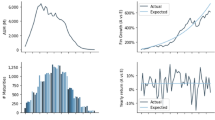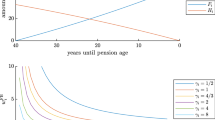Abstract
This paper focuses on defined-benefit pension funds in which heterogeneous plan members differ in age, salary, contribution rate, and other characteristics. The co-variation of these characteristics proves to have an important effect on the management of the fund. For example, we find that members’ ages and salary growths, if co-vary in unfavourable way, can substantially increase the funds’ liability, which in turn drives up the amount of funding required and the proportion of risky investment. This coupling effect of heterogeneity is demonstrated first through analytical statements which we derive under a simplified assumption of no investment constraints. In constrained cases for which analytical solutions are unavailable, we develop a numerical method that finds the heterogeneity-adjusted management decisions using a so-called adaptive representative agent (ARA), whose characterization is given explicitly in a key theorem. Whereas traditional methods often suffer from numerical complexity that grows exponentially with the number of heterogeneous members, the computational cost of the proposed ARA method is only linear in the number of time steps. This advantage of the ARA method and its ability to rectify the coupling effects of heterogeneity are demonstrated through our numerical example.





Similar content being viewed by others
Data availability
The data that support the findings of this study are available from the corresponding author upon request.
Code availability
The codes that produce the data of this study are available from the corresponding author upon request.
References
Ayres, I., Nalebuff, B.: Diversification across time. J. Portf. Manag. 39(2), 73–86 (2013)
Benzoni, L., Collin-Dufresne, P., Goldstein, R.: Portfolio choice over the life-cycle when the stock and labor markets are cointegrated. J. Finance LXII(5), 2123–2168 (2007)
Cairns, A.J.G., Blake, D., Dowd, K.: Stochastic lifestyling: optimal dynamic asset allocation for defined contribution pension plans. J. Econ. Dyn. Control 30, 843–877 (2006)
Colombo, L., Haberman, S.: Optimal contributions in a defined benefit pension scheme with stochastic new entrants. Insur. Math. Econ. 37, 335–354 (2005)
Cox, S.H., Lin, Y., Tian, T., Yu, J.: Managing capital market and longevity risks in a defined benefit pension plan. J. Risk Insur. 80(3), 585–619 (2013)
Cremer, H., Gahvari, F., Pestieau, P.: Pensions with heterogenous individuals and endogenous fertility. J. Popul. Econ. 21, 961–981 (2008)
Danswasvong, T., Suchintabandid, S.: Heterogeneity effects on the management of retirement fund. Appl. Econ. 51, 2043–2060 (2019)
Delong, L., Gerrard, R., Haberman, S.: Mean–variance optimization problems for an accumulation phase in a defined benefit plan. Insur. Math. Econ. 42, 107–118 (2008)
Haberman, S., Sung, J.H.: Optimal pension funding dynamics over infinite control horizon when stochastic rates of return are stationary. Insur. Math. Econ. 36(1), 103–116 (2005)
Honda, T.: Dynamic optimal pension fund portfolios when risk preferences are heterogeneous among pension participants. Int. Rev. Finance 12(3), 329–355 (2012)
Josa-Fombellida, R., Rincon-Zapatero, J.P.: Optimal risk management in defined benefit stochastic pension funds. Insur. Math. Econ. 34(3), 489–503 (2004)
Laun, T., Wallenius, J.: A life cycle model of health and retirement: THE case of Swedish pension reform. J. Public Econ. 127, 127–136 (2015)
Vigna, E., Haberman, S.: Optimal investment strategy for defined contribution pension schemes. Insur. Math. Econ. 28(2), 233–262 (2001)
Acknowledgements
We are grateful to Christian Wolff, Paul Malatesta, Manapol Ekkayokkaya, Thaisiri Watewai, Anant Chiarawongse, and Tanawit Sae-Sue, who provided us with valuable comments.
Funding
Not applicable.
Author information
Authors and Affiliations
Corresponding author
Ethics declarations
Conflict of interest
The authors report no conflicts of interest.
Additional information
Publisher's Note
Springer Nature remains neutral with regard to jurisdictional claims in published maps and institutional affiliations.
Appendices
Appendix I: Proof of Proposition 3.1
Before proving Proposition 3.1, let us first rewrite (3.1–3.2) by substituting the \({A}_{i,t}\) and \({B}_{i,t}\) from (3.3–3.4) to yield:
where \({\mathcal{M}}_{t}\,{:}{=}\,\frac{1}{1+r}{\sum }_{i=1}^{N}{B}_{i,t+1}{K}_{i}{\left(1+{\mu }_{i}\right)}^{{\tau }_{i}-t}{S}_{i,t}\), \({\mathcal{S}}_{t}\,{:}{=}\,\frac{1}{1+r}{\sum }_{i=1}^{N}{B}_{i,t+1}{K}_{i} (1+{\mu }_{i})^{{\tau }_{i}-t-1} \beta_{i} S_{i,t}\), and \({Q}_{t}={\sum }_{i=1}^{N}{\pi }_{i,t}^{^{\prime}}{S}_{i,t}\) (see (2.2)). Recall the definition that \({u}_{t}=1\) if no one retires at time \(t\), and \({u}_{t}=1+{x}_{t}\) otherwise. In order to verify (A.1–A.2), the key is to show that the value function \({V}_{t}\left({W}_{t},{\mathbf{S}}_{t}\right)\) defined in (2.9) has the following form for all \(t\):
where \({\Psi }_{\mathrm{t}}\,{:}{=}\,{\sum }_{i=1}^{N}{\sum }_{j=1}^{N}{v}_{ij,t}{S}_{i,t}{S}_{j,t}\) is a quadratic form in \({S}_{i,t}\)’s with some fixed coefficients \({v}_{ij,t}\), independent of \({W}_{t}\). (The second equality in (A.3) follows directly from (3.3) and the definition of \({\mathcal{M}}_{t}\), \({\mathcal{S}}_{t}\), and \({Q}_{t}\).)
Let us prove (A.3) by induction on \(t\). We begin by substituting \({R}_{t}\) from (2.3) into (2.5), to obtain \({W}_{t+1}=\left(\xi +{Z}_{t}\right){\Omega }_{t}+{\Upsilon }_{t}+{X}_{t}\), where
Let \({\Gamma }_{\mathrm{t}}\,{:}{=}\,{\left[ {\Omega }_{\mathrm{t}} \left({\Upsilon }_{\mathrm{t}}+{X}_{t}\right)/{x}_{t }\right]}\). Then, (2.5) can be further simplified as\({W}_{t+1}={\Gamma }_{t }{\left[ \xi +{Z}_{t} {x}_{t }\right]}^{T}\). Combined with \({S}_{i,t+1}={S}_{i,t}\left(1+{\mu }_{i}+{\alpha }_{i}{Y}_{i,t}+{\beta }_{i}{Z}_{t}\right)\) and the assumption that \({Y}_{i,t}\) and \({Z}_{t}\) are independent \(\mathcal{N}\left(\mathrm{0,1}\right)\)’s, we can write
Therefore, assuming that (A.3) holds at time \(t+1\), we can write \({E}_{t}\left[{V}_{t+1}/{x}_{t}\right]\) as
Note that, since \({\Psi }_{t+1}\) is quadratic in \({S}_{i,t+1}\)’s and \({E}_{t}\left[{S}_{i,t+1}{S}_{j,t+1}\right] = {S}_{i,t}{S}_{j,t}\left(1+{\mu }_{i}+{\mu }_{j}+{\mu }_{i}{\mu }_{j}+{\beta }_{i}^{2}+{\alpha }_{i}^{2}{1}_{\left\{i=j\right\}}\right)\), the last term \(E\left[{\Psi }_{t+1}\right]\) is quadratic in \({S}_{i,t}\)’s.
Case 1: No retirement at time \({\varvec{t}}\) In this case \({X}_{t}=0\), \({\Gamma }_{\mathrm{t}}={\left[ {\Omega }_{\mathrm{t}} {\Upsilon }_{\mathrm{t}}/{x}_{t }\right]}\) and equation (A.4) simplifies to:
The solution \({\Omega }_{t}^{*}\) that minimizes the above expression (which is simply quadratic in \({\Omega }_{t}\)) can be easily found as
Since \({\Omega }_{\mathrm{t}}^{*}={\sigma }{p}_{t}^{*}{W}_{t}\) and \({\Upsilon }_{\mathrm{t}}=\left(1+r\right){W}_{t}+{Q}_{t}\), the above equation gives \({p}_{t}^{*}\) that confirms (A.1). Moreover, according to (2.9), the value function \({V}_{t}\) at time \(t\) is obtained by substituting the minimizer \({\Omega }_{\mathrm{t}}^{*}\) into (A.5):
Substituting \({x}_{t-1}={x}_{t}/\left(1+{\xi }^{2}\right)\) and \({\Upsilon }_{t}=\left(1+r\right){W}_{t}+{Q}_{t}\), and letting \({\Psi }_{t}={\left({\mathcal{M}}_{t}-\xi {\mathcal{S}}_{t}-{Q}_{t}\right)}^{2}+{\mathcal{S}}_{t}^{2}-{\mathcal{M}}_{t}^{2}-{\xi }^{2}\left({\mathcal{S}}_{t}^{2}+{\mathcal{M}}_{t}^{2}\right)+{x}_{t}E\left[{\Psi }_{t+1}\right]/{x}_{t-1}\), one can show that the display equation above is equivalent to (A.3).
Case 2: Some members retire at time \(\,{\varvec{t}}\) Combining (A.4) with \({X}_{t}^{2}={\left({X}_{t}+{\Upsilon }_{t}\right)}^{2}+{\Upsilon }_{t}^{2}-2{\Upsilon }_{t}\left({X}_{t}+{\Upsilon }_{t}\right)\), we obtain
The solution \({\Gamma }_{t}^{*}\) that minimizes the above expression (which is simply quadratic in \({\Gamma }_{t}\)) can be easily found as
where \({u}_{t}=1+{x}_{t}\). With \({\Gamma }_{t}^{*}\,{:}{=}\,{\left[ \sigma {p}_{t}^{*}{W}_{t} \left({\Upsilon }_{\mathrm{t}}+{X}_{t}^{*}\right)/{x}_{t }\right]}\) and \({\Upsilon }_{\mathrm{t}}=\left(1+r\right){W}_{t}+{Q}_{t}\), one can show that the above equation gives \({p}_{t}^{*}\) and \({X}_{t}^{*}\) that confirm (A.1–A.2). And from (2.9), \({V}_{t}\) is obtained by substituting the minimizer \({\Gamma }_{\mathrm{t}}^{*}\) into (A.7):
Substituting \({x}_{t-1}={x}_{t}/\left(1+{\xi }^{2}\right)\) and \({\Upsilon }_{t}=\left(1+r\right){W}_{t}+{Q}_{t}\), and letting \({\Psi }_{t}={\left({\mathcal{M}}_{t}-\xi {\mathcal{S}}_{t}-{Q}_{t}\right)}^{2}-\left({u}_{t}+{\xi }^{2}\right)\left({\mathcal{S}}_{t}^{2}+{\mathcal{M}}_{t}^{2}\right)+{x}_{t}E\left[{\Psi }_{t+1}\right]/{x}_{t-1}\), one can show that the display equation above is equivalent to (A.3).
Thus, in both cases above, we have shown for an arbitrary \(t\) that if (A.3) holds at time \(t+1\), then it also holds at time \(t\). Recall that \({V}_{{\tau }_{N}}\), by construction, satisfies the boundary condition:
Thus, referring to the fact that \({B}_{N,{\tau }_{N}}=1+r\) and \({x}_{{\tau }_{N}-1}=1\) and letting \({\Psi }_{{\tau }_{N}}={\left(1+r\right)}^{2 }{K}_{N }^{2}{Y}_{N,{\tau }_{N }}^{2}\), one can see that (A.3) holds for \(t={\tau }_{N}\). Hence, by induction, we (A.3) is verified for all \(t\le {\tau }_{N}\), and so are the optimal decisions \({p}_{t}^{*}\) and \({X}_{t}^{*}\).
Appendix II: Proof of Proposition 4.1
Because of (4.4C) and (4.4G), multiplying both sides of (4.4H) by \(1+{\mu }_{i}\) and then summing over \(i=1\) to \(N\) yields
where \({\mathcal{M}}_{t}\) is as defined in Appendix I. And because of (4.4E), multiplying both sides of (4.4H) by \({\beta }_{i}\) and then summing over \(i=1\) to \(N\) yields
where \({\mathcal{S}}_{t}\) is as defined in Appendix I. If we substitute \({A}_{R,t}\) from (4.2) into (4.1) and use (A.8–A.9), we can rewrite \({\widehat{p}}_{R,t}\) in terms of \({\mathcal{M}}_{t}\) and \({\mathcal{S}}_{t}\) as:
Because (2.2) and (4.4B) imply that \({Q}_{t}={\pi }_{R}{S}_{R}\), one can readily see that \({\widehat{p}}_{R,t}\) in (A.10) matches exactly \({p}_{t}^{*}\) in (A.1). Hence, Proposition 4.1 is proved.
Rights and permissions
Springer Nature or its licensor (e.g. a society or other partner) holds exclusive rights to this article under a publishing agreement with the author(s) or other rightsholder(s); author self-archiving of the accepted manuscript version of this article is solely governed by the terms of such publishing agreement and applicable law.
About this article
Cite this article
Danswasvong, T., Suchintabandid, S. Heterogeneity-adjusted management of pension funds using adaptive representative agents. Decisions Econ Finan 46, 545–567 (2023). https://doi.org/10.1007/s10203-022-00384-9
Received:
Accepted:
Published:
Issue Date:
DOI: https://doi.org/10.1007/s10203-022-00384-9
Keywords
- Heterogeneity
- Optimal asset allocation
- Defined-benefit pension fund
- Stochastic control
- Dynamic programming




